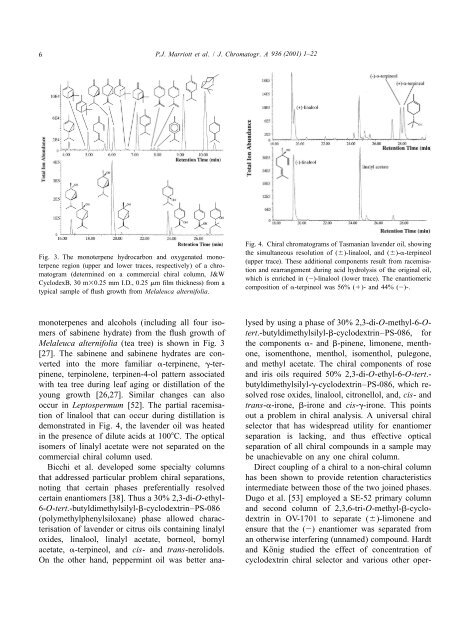Gas chromatographic technologies for the analysis of essential oils
Gas chromatographic technologies for the analysis of essential oils
Gas chromatographic technologies for the analysis of essential oils
You also want an ePaper? Increase the reach of your titles
YUMPU automatically turns print PDFs into web optimized ePapers that Google loves.
6 P.J. Marriott et al. / J. Chromatogr. A 936 (2001) 1–22<br />
Fig. 3. The monoterpene hydrocarbon and oxygenated monoterpene<br />
region (upper and lower traces, respectively) <strong>of</strong> a chro-<br />
matogram (determined on a commercial chiral column, J&W<br />
CyclodexB, 30 m30.25 mm I.D., 0.25 mm film thickness) from a<br />
typical sample <strong>of</strong> flush growth from Melaleuca alternifolia.<br />
Fig. 4. Chiral chromatograms <strong>of</strong> Tasmanian lavender oil, showing<br />
<strong>the</strong> simultaneous resolution <strong>of</strong> (6)-linalool, and (6)-a-terpineol<br />
(upper trace). These additional components result from racemisation<br />
and rearrangement during acid hydrolysis <strong>of</strong> <strong>the</strong> original oil,<br />
which is enriched in (2)-linalool (lower trace). The enantiomeric<br />
composition <strong>of</strong> a-terpineol was 56% (1)- and 44% (2)-.<br />
monoterpenes and alcohols (including all four iso- lysed by using a phase <strong>of</strong> 30% 2,3-di-O-methyl-6-Omers<br />
<strong>of</strong> sabinene hydrate) from <strong>the</strong> flush growth <strong>of</strong> tert.-butyldimethylsilyl-b-cyclodextrin–PS-086, <strong>for</strong><br />
Melaleuca alternifolia (tea tree) is shown in Fig. 3 <strong>the</strong> components a- and b-pinene, limonene, menth-<br />
[27]. The sabinene and sabinene hydrates are con- one, isomenthone, menthol, isomenthol, pulegone,<br />
verted into <strong>the</strong> more familiar a-terpinene, g-ter- and methyl acetate. The chiral components <strong>of</strong> rose<br />
pinene, terpinolene, terpinen-4-ol pattern associated and iris <strong>oils</strong> required 50% 2,3-di-O-ethyl-6-O-tert.-<br />
with tea tree during leaf aging or distillation <strong>of</strong> <strong>the</strong> butyldimethylsilyl-g-cyclodextrin–PS-086, which reyoung<br />
growth [26,27]. Similar changes can also solved rose oxides, linalool, citronellol, and, cis- and<br />
occur in Leptospermum [52]. The partial racemisa- trans-a-irone, b-irone and cis-g-irone. This points<br />
tion <strong>of</strong> linalool that can occur during distillation is out a problem in chiral <strong>analysis</strong>. A universal chiral<br />
demonstrated in Fig. 4, <strong>the</strong> lavender oil was heated selector that has widespread utility <strong>for</strong> enantiomer<br />
in <strong>the</strong> presence <strong>of</strong> dilute acids at 1008C. The optical separation is lacking, and thus effective optical<br />
isomers <strong>of</strong> linalyl acetate were not separated on <strong>the</strong> separation <strong>of</strong> all chiral compounds in a sample may<br />
commercial chiral column used.<br />
be unachievable on any one chiral column.<br />
Bicchi et al. developed some specialty columns Direct coupling <strong>of</strong> a chiral to a non-chiral column<br />
that addressed particular problem chiral separations, has been shown to provide retention characteristics<br />
noting that certain phases preferentially resolved intermediate between those <strong>of</strong> <strong>the</strong> two joined phases.<br />
certain enantiomers [38]. Thus a 30% 2,3-di-O-ethyl- Dugo et al. [53] employed a SE-52 primary column<br />
6-O-tert.-butyldimethylsilyl-b-cyclodextrin–PS-086 and second column <strong>of</strong> 2,3,6-tri-O-methyl-b-cyclo-<br />
(polymethylphenylsiloxane) phase allowed charac- dextrin in OV-1701 to separate (6)-limonene and<br />
terisation <strong>of</strong> lavender or citrus <strong>oils</strong> containing linalyl ensure that <strong>the</strong> (2) enantiomer was separated from<br />
oxides, linalool, linalyl acetate, borneol, bornyl an o<strong>the</strong>rwise interfering (unnamed) compound. Hardt<br />
acetate, a-terpineol, and cis- and trans-nerolidols. and Konig ¨ studied <strong>the</strong> effect <strong>of</strong> concentration <strong>of</strong><br />
On <strong>the</strong> o<strong>the</strong>r hand, peppermint oil was better ana- cyclodextrin chiral selector and various o<strong>the</strong>r oper-











![Bericht von Schimmel & Co. [Inhaber Gebr. Fritzsche] in Leipzig](https://img.yumpu.com/24438150/1/171x260/bericht-von-schimmel-co-inhaber-gebr-fritzsche-in-leipzig.jpg?quality=85)




